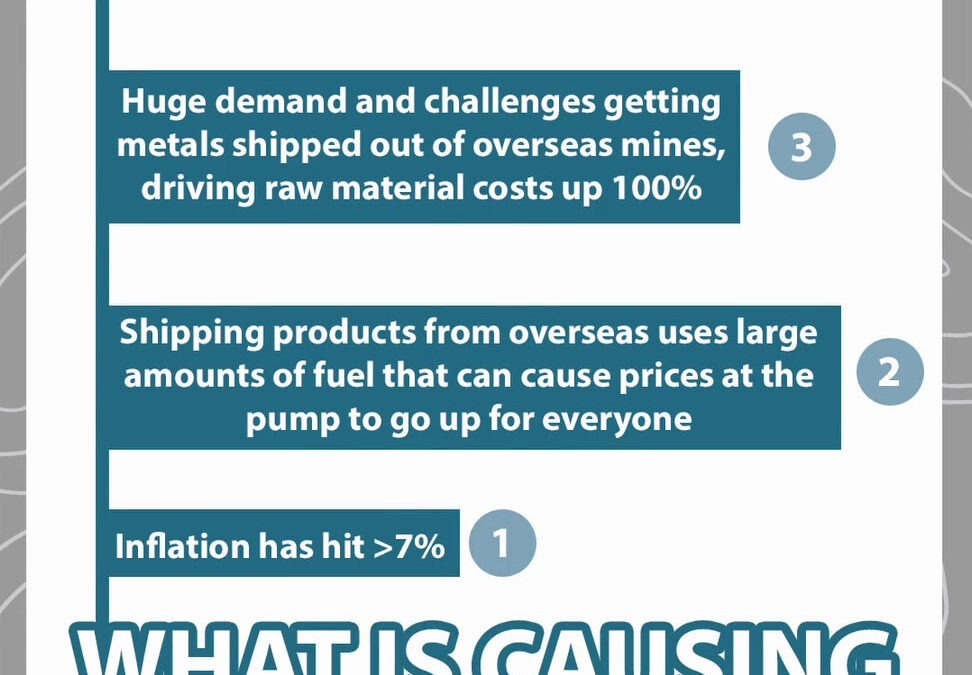Inflation has been rising recently, hitting over 7%, and has been causing the average price of items to increase with it. Things are tending to cost more and more, but why? How is the global supply chain involved, what role does manufacturing play in all of this and how are we, as consumers affected? To dive deeper, let’s first get a better idea of what inflation is.
What exactly is inflation?
Inflation is the increase in prices of goods and services in an economy1. It can be caused by demand-pull inflation, referring to demand exceeding supply, consequently causing the price to increase. We can observe that in the price of gas. Due to high demand for crude oil and the low supply of it, there has been a growth in its price2 because more people want it than what is readily available. Inflation may also be caused by cost-push inflation, which describes the cost of producing being high, which in turn forces businesses to raise prices as well. If a certain product’s material or manufacturing process is high, the product or service would ergo be higher as well to cover the costs to maintain a profit margin. Another cause of inflation is built-in inflation. This is when workers demand higher wages to keep up with the rising living costs and businesses must respond with higher prices products/services in order to afford these increased wages.
How does local manufacturing help?
One of the main issues manufacturers are experience now is overseas shipping. Shipping expenses (including fuel costs, which have seen a surge) have been steadily climbing. This translates into to higher priced products in order to cover such heavy costs.
Fuel costs
Shipping products from overseas has a knock-on effect on global fuel prices as well. Since intercontinental shipping uses such an immense amount of fuel, it can cause the prices at the pump to go up for everyone else.
Raw material sourcing
With offshore manufacturing, raw materials are often shipped across the ocean to the factory and the finished good shipped back across to the final market. Not only has the cost of certain raw materials increased as much as 100% since 2020, they are compounded with long distance 2-way shipping. With the price of brass skyrocketing, plumbing manufacturers have had to find innovative ways to keep costs down and supply steady.
Without tightly controlled supply chains and the ability to rapidly reduce waste in manufacturing many companies have been forced to increase the price of their final goods to to deal with these cost increases within the supply chain.
The impact of increased lead times
Lead time on raw materials have increased too, delaying manufacturing by 2-8 months. This delay causes compounding delays further down the manufacturing and sales chain. A delay in receiving raw material can cause a factory to sit idle which costs money the manufacturer must pass on to the final customer. The delay in delivering finished goods to the customer can cause idle time on construction projects which again costs more money. Some reasons for lead time delays may be traced to natural disasters, the COVID-19 pandemic, raw material shortages or human error3.
The local solution
A big thing that can help tackle inflation and supply chain problems is local manufacturing. With local manufacturing, it reduces reliance on cross-ocean shipping and reduces exposure to increased shipping costs and delays that would sooner or later lead to inflation. Given the higher level of control over inputs, businesses can more accurately plan production schedules allowing them to offer or maintain lower price points. Local manufacturing also relies more heavily on locally-sources materials which also encourages local prosperity4 as well as eliminates the risk of potentially long waits for international shipments of materials.
The key factor that has allowed Tapmaster to hold its price increases to less than 2% a year for the last 5 years is our commitment to local manufacturing. Our competitors, on the other hand, have experienced increased prices of 5-10% per year within the same time period by not manufacturing locally.
Needless to say, local manufacturing can not only aid businesses but also make it better for customers by limiting inflation. The fact that local manufacturing generates high quality jobs in the community also helps people afford the current increased cost of living where inflationary forces cannot be so easily mitigated.

